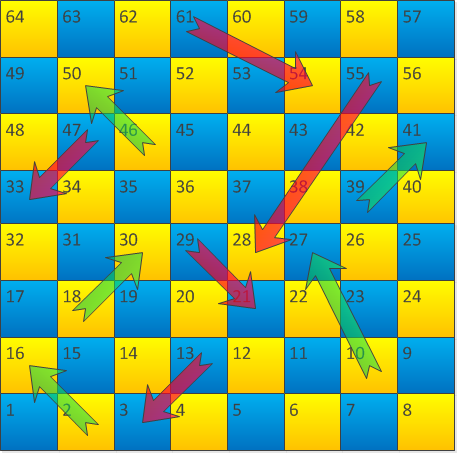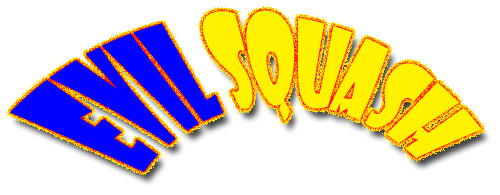
The game is played on a rectangular grid of locations on a board as shown above. It can be played by up to four players, each of which has a marker.
Evil Squash
Each player takes it in turn to throw one dice. They start off the board and move their marker onto the board with their first throw. At each turn they must then move their marker that number of squares over the board. If they land on the base of an arrow they must then move their marker onto the destination given by that arrow. Green arrows are good news, red arrows are bad news.
In the land of Evil Squash it is not possible to have two players on the same square. Whenever a player lands on (squashes) another player they can do one of two things:
- Perform a “Squash Bounce”, throw the dice and move again.
- Perform an “Evil Squash” and put the player they squashed in the square they have just left.
If a player lands on another player as the result of a “Squash Bounce” throw they must perform an “Evil Squash” and send the squashed player back to their original starting square.
If a player throws a six and lands on an empty square they are allowed another throw. The first player to reach square 64 is the winner. An exact throw is not required.
A PDF of the Game Rules and the board is here.
A high resolution image of the board is here.
We are presently writing some programs to play this game. If we get any good ones we will post them here too.
Evil Squash, with Evil Cards
To make the game even more interesting we could give each player four randomly dealt cards at the start of the game. These are their "squash" cards and are marked either "Bounce" or "Squash". They can be played to perform a squash or a bounce (depending on the type of card) when a player lands on another. When a card is played it is discarded and cannot be used again. Players keep the cards secret.
If a player doesn't have a squash or a bounce card and makes a throw that would cause them to land on another player, they cannot move.
This makes the game even more strategic, in that now you have to decide when best to play your cards and worry about what cards other players might have.
And it makes the program more complicated too.
